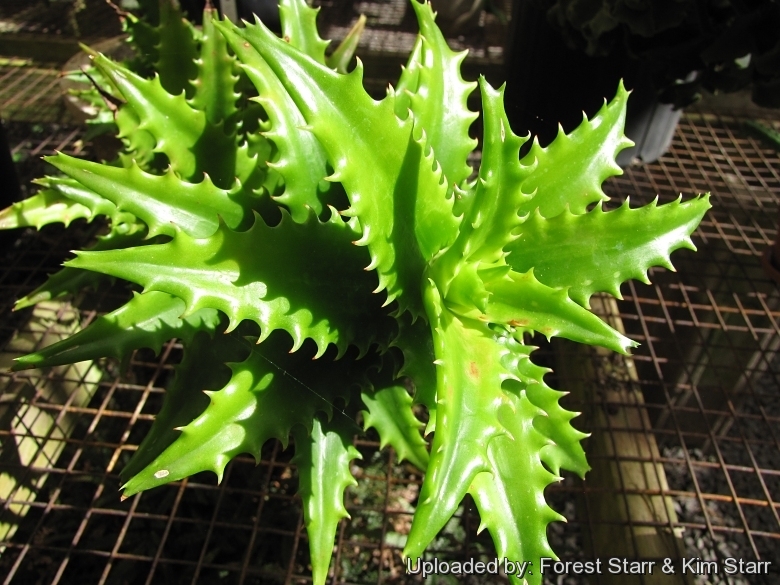Accepted Scientific Name: Aloe buettneri A.Berger
Bot. Jahrb. Syst. 36: 60 1905

Aloe congolensis Photo by: Forest Starr & Kim Starr
Habit at Sacred Garden of Maliko, Maui, Hawaii (USA). January 24, 2011.
Origin and Habitat: The plants first described came from sandy bush near Kimuenza in the Congo.
Synonyms:
See all synonyms of Aloe buettneri
back
Accepted name in llifle Database:Aloe buettneri A.BergerBot. Jahrb. Syst. 36: 60 1905Synonymy: 7
back
Common Names include:
ENGLISH: Congo aloe, Tiger tooth aloe
Description: Aloe congolensisSN|29228]]SN|29228]] (Congo Aloe) is a small aggressive clustering aloe to 15 to 20 cm tall that forms tight 12 cm wide rosettes with short bright green shiny wedge-shaped leaves with slight recurved tip and sharp teeth. The stems lie along the ground to 60 cm long and the eaves are often retained the entire length of the stem, though eventually slough off.
Leaves: Short, stiff, shiny bright green, almost plastic-like, wedge-shaped and somewhat flat to recurving near the tips. Leaves take on a reddish-brown cast when drought or cold stressed. The leaves are heavily armed with large, sharp teeth the same colour as the leaves.
Flowers: In late fall to early winter appear a 30 or more cm tall unbranched inflorescence with pinkish-red or reddish-orange flowers in late autumn to mid winter. It seems to take the plant years to mature enough to get to flowering size.
Taxonomic notes: The name Aloe congolensisSN|29225]]SN|29228]] is not a verified species name but it is a very common plant, often seen in garden centres and has long been cultivated and passed around under this name which was first used by De Wildeman and T. Durand in 1899 but this name is often noted as “imperfectly known or doubtful” as Gilbert Reynolds does in “Aloes of Tropical Africa and Madagascar”. The entry for this plant in this book notes that the plants first described came from sandy bush near Kimuenza in the Congo and that it may be conspecific with Aloe buettneriSN|29228]]SN|29225]], though images of this plant look much different and Aloe buettneri is described as having wider leaves and a bulb-like swelling not apparent in the plants known as Aloe congolensisSN|29228]]SN|29228]]. This name also does not appear in Aloes: The Definite Guide published in 2011.
Subspecies, varieties, forms and cultivars of plants belonging to the Aloe buettneri group
- Aloe buettneri A.Berger: up to 30-85 cm tall, without stem, usually solitary with leaf bases forming a bulb-like rootstock. Distribution: West Africa from Senegal to Nigeria
 Aloe congolensis De Wild. & T.Durand: clustering and sprawling 15-20 cm tall. Rosettes 12 cm wide with short plastic-like wedge-shaped leaves with slight recurved tip and sharp teeth. Distribution: Kimuenza; Congo.
Aloe congolensis De Wild. & T.Durand: clustering and sprawling 15-20 cm tall. Rosettes 12 cm wide with short plastic-like wedge-shaped leaves with slight recurved tip and sharp teeth. Distribution: Kimuenza; Congo.
Bibliography: Major references and further lectures
1) Forest & Kim Starr “Aloe congolensis (tiger tooth aloe)”. Plants of Hawaii. <http://www.starrenvironmental.com>. Web. 27 Sep. 2014.
2) San Marcos Growers contributors “Aloe congolensis - Congo Aloe ” San Marcos Growers <http://www.smgrowers.com>. Web. 27 Sep. 2014.
3) Davesgarden's contributors “PlantFiles: Aloe congolensis” <http://davesgarden.com> Web. 14 Sep. 2014.
Cultivation and Propagation: Aloe congolensis is a very easy species, and easy to find, too (commonly sold at outlet garden centres). It is an aggressive offsetter that fills out small pans to form very attractive small domes, and will eventually take over an area.. To reach this state, however it requires patience and a careful hand with watering. It makes a nice potted specimen or even a hanging basket plant. Given the right conditions they can be grown as a houseplant.
Growth rate: This is the slow to moderate growing aloe, and it will tolerate drought and neglect once established.
Soil: Grow it in light, fertile, well-drained, moderate soils, with a slightly acidic pH (5-6).
Fertilization: It needs a perfect fertilizer diet in summer. Use preferably a cacti and succulents fertilizer with high potassium content including all micro nutrients and trace elements or slow release fertilizer.
Watering: Water regularly in spring and summer, keep drier in winter.
Exposure: Prefer half shade (kept away from direct sun in summer) but it will get nicely redder colour with brighter light (not direct sun).
Hardiness: This plant doesn't like cold weather, therefore in the Spring it is best to set it outside only when the temperatures are above 15°C. Can endure temperatures below 5°C for short period, but only if the soil stays completely dry.
Pests and diseases: This plant is particularly prone to aloe mite damage.
Maintenance: Removal of old flower stalks; It is a suckering species, and one plant can eventually cover a large area. Divide the crowded clumps periodically. During the winter months, the plants should be grown cool to initiate flower development (about 5-10°C).
Warning: It has sharp thorns and is one of the more painful aloes to trim without gloves.
Traditional uses: In western Democratic Republic of Congo the leaf sap of Aloe congolensis is traditionally used to cure sores, wounds, burns. pain in the joints, inflammation of the breast and as a laxative, whereas dried and powdered leaves are said to prevent cancer of the colon and rectum.
Reproduction: Usually by Offsets or (rarely) by seeds, it has to be restarted periodically as the lower leaves shed and it looks bare. Take a branch or stem cut off, allow it to dry for a day or so until the wound has sealed, and then plant it in well-drained soil or sand. They need not be rooted in any particular place and then transplanted, but can be placed directly into their permanent place in the garden. This aloe can also be grown from seed, sown in spring. Seed should take three to four weeks to germinate, and the seedlings must be protected from frost.










